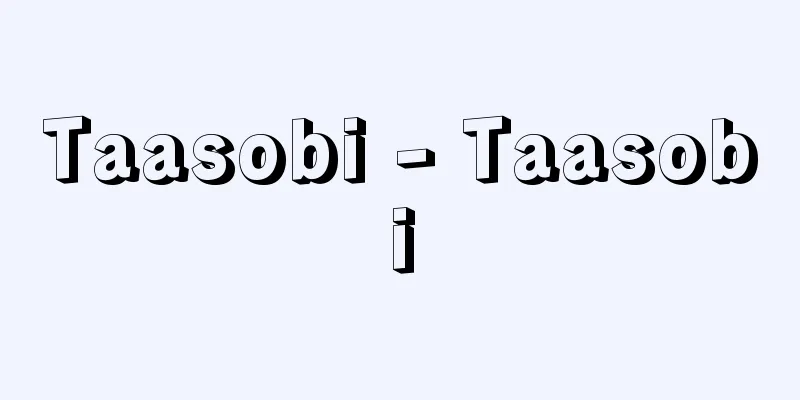Taasobi - Taasobi

|
Performing arts for the Spring Toshigoi Festival. It originated from the spring rites for the start of farming, centered on rice cultivation, and developed into performing arts; it is completely different from Dengaku. There are approximately 330 places throughout the country that correspond to this Tayu. Among them, the name Tayu is mainly limited to the Tokaido region, while from the Kinki region westward it is mainly called Ondaue, or Onda for short. Most of these are New Year's events, and are limited to the depiction of rice planting; only some Tayu with performing arts aspects go on to depict the scene of a good harvest. The spring rites for the start of farming had been held since before the calendar system was introduced, and the February Toshigoi Festival was established based on this practice. According to the Enryaku Ritual Book from the early Heian period, at Ise Kotai Jingu Shrine, a festival was held to worship the New Year God in the sacred rice fields on the first day of the month of February, and a ritual was held in which the first plowing and sowing of seeds were performed. At the beginning of the Kamakura period, an imitation of rice planting was added to this, and the Kenkyu Ritual Book states, "The rice-planting ritual of sowing straw." This was the first appearance of the term rice-planting. The first harvesting ritual in February can be seen at Atsuta Jingu Shrine (Aichi Prefecture) and other ancient shrines, but it was merely a ritual and could be said to have preceded the performing art of rice-planting. The formation of Ta-yu as a performing art cannot be overlooked as it was an aspect of temple events. The majority of Ta-yu across the country were New Year events, and in fact many were held at Shusho-e ceremonies at ordinary temples and shrines. The "rituals" that run from the first quarter of the first month of the year to the first month of the lunar calendar began with the reign of Empress Jito in the Asuka period and had the character of a prayer year. From the mid-Heian period, Shusho-e ceremonies were held at the completion of the rituals, and "Ennen" banquets and entertainment were held. It is believed that Ta-yu as a performing art developed during these Ennen festivals, when Ta-uta and Furyu rice planting were performed. The Ennen rice festival incorporates the ceremonial elements of the beginning of the rice harvest, includes rice cultivation by the Tonobarashu (the headman and official of the manor village) from the fields offered to the gods and Buddha, and utilizes classical rice songs, and learns the techniques of Sarugaku, Kyogen, and Senzumanzai, creating a total performing art from the rice cultivation to the harvest. It can be estimated that this period was from the Kamakura to the Muromachi period. The rice festivals in the former Koyasan manor area of the Kii Peninsula and along the Tokaido route retain the vestiges of the social background of the manor system along with the Shussetsukai, and the rice festivals in the Hokuriku region convey the profound content of the Senzumanzai method to the present day. The rice festivals handed down in Tokumaru and Akatsuka in Itabashi Ward, Tokyo, are designated as Important Intangible Folk Cultural Properties of Japan. [Tsuneyasu Arai] "A Study of Agriculture and Field Activities by Tsuneyasu Arai, 2 volumes (1981, Meiji Shoin)" Source: Shogakukan Encyclopedia Nipponica About Encyclopedia Nipponica Information | Legend |
|
春の祈年祭(としごいのまつり)の芸能。稲作を中心にした春の耕作始めの儀礼に発し、芸能に成長したものをいい、田楽(でんがく)とはまったく異なる。この田遊に相当するものは、全国に約330か所伝えられてきた。そのなかで田遊の呼称はおもに東海道に限られ、近畿地方から西では主として御田植(おんだうえ)、略して御田(おんだ)とよぶ。これらの多くは正月行事であり、また田植までの表現にとどまっており、収穫の豊年のさままで演じるのは一部の芸能性をもつ田遊だけである。春の耕作始めの儀礼は暦制以前から行われていたが、その慣行を前提に2月の祈年祭が成立した。平安初期の『延暦(えんりゃく)儀式帳』によると、伊勢(いせ)皇太神宮の例では、2月初子(はつね)の日に神田(みとしろ)で年神(としがみ)を祭り、墾(は)り初(ぞ)めをして種を播(ま)く種下(たねおろ)しの儀礼を行っていた。鎌倉時代の初めになるとそれに田植のものまねが加わり、『建久(けんきゅう)儀式帳』には「以藁殖(わらうえる)田遊作法」とある。これが田遊の用語の初見である。2月の作始めの儀礼は熱田(あつた)神宮(愛知県)ほかの古社にもみえるが、それは儀礼にとどまるもので、芸能の田遊以前といえよう。 芸能としての田遊の成立には、寺院の行事の側面を見逃せない。全国の田遊の大勢は正月行事であり、事実、一般の寺院や神宮寺(じんぐうじ)の修正会(しゅしょうえ)に行われてきたものが多い。暦法による年頭正月の上弦(しょうげん)から上元(じょうげん)に至る「修法(おこない)」は、飛鳥(あすか)時代の持統(じとう)朝から始まり、祈年(としごい)の性格をもっていた。平安中期からその修法の完了の段階で修正会が開かれ、宴遊の「延年(えんねん)」が催される。この延年のなかで田歌(たうた)や田植風流(ふりゅう)が演じられ、芸能の田遊が育っていったものとみられる。修正延年の田遊は、作始めの儀礼的要素を取り込み、神仏の供田(くでん)から殿原衆(とのばらしゅう)(荘園(しょうえん)村落内の名主(みょうしゅ)や荘官などの階層)などの田作りを含め、古典田歌を活用して、猿楽(さるがく)、狂言、千秋万歳(せんずまんざい)の手法を学び、田打ちから収穫までのトータルな芸能としての内容をつくりあげた。その時期は鎌倉から室町期と推定できる。紀伊半島のかつての高野山(こうやさん)荘園地域や東海道筋の田遊では、修正会とともに荘園制の社会的背景のおもかげをとどめ、北陸地方の田遊は千秋万歳方式の重厚な内容をいまに伝えている。なお、東京都板橋区徳丸、赤塚に伝承する田遊は国の重要無形民俗文化財に指定されている。 [新井恒易] 『新井恒易著『農と田遊びの研究』全二巻(1981・明治書院)』 出典 小学館 日本大百科全書(ニッポニカ)日本大百科全書(ニッポニカ)について 情報 | 凡例 |
Recommend
Kubogai (Kubo shell) - Kubogai (English spelling) Chlorostoma argyrostoma
A snail shell of the family Celastridae (illustrat...
Chronegk, L. (English spelling) ChronegkL
…However, this “historical faithfulness” was mere...
Kagai - Kagai
… [Taro Obayashi] [Ancient Japanese Singing Festi...
Inbred - Golden pheasant
A genetically homogeneous population of plants or ...
Okura Museum of Art
Located in Toranomon, Minato-ku, Tokyo, this is Ja...
Bar do thos grol
A Tibetan esoteric Buddhist text. It is commonly c...
Ahaara - Ah ha ha
…The kingdom was ruled by vassals such as rajas, ...
Foreign exchange market - gaikoku kawase shi jo (English spelling)
A market where different currencies (for example, ...
Swatantra
After India's independence, he served as the ...
Brugia malayi (English spelling) Brugiamalayi
…Adult worms are long and thread-like and infest ...
Pantomimes
...It is also simply called "mime", and...
Celestial photometry
The accurate measurement of the amount of light fr...
Pseudocrystal - Kasho
A mineral that has been replaced by another minera...
Live fish - Katsugyō
Seafood is supplied alive until just before cookin...
clouds
…Of course, Japanese kasuri, which developed rema...









